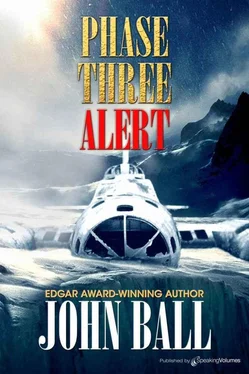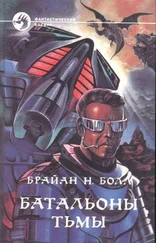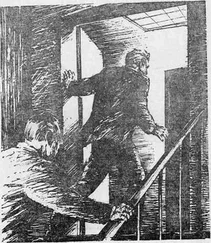Seligman acknowledged and broke off. The main rotor whirled faster, the Sikorsky rolled forward a few feet and lifted off.
As soon as he was safely airborne, Kimsey set up a long climbing turn toward the north. His aircraft bucked underneath him and swayed dangerously as sharp gusts hit it, but he had expected that. It was an insane night to be flying, but that consideration had to be ignored. At 3,000 feet he leveled off and set up the best cruising speed that he dared under those weather conditions. He pushed the transmit button. “Thule from Jolly One,” he said. “Tell Kanak we’re on our way.”
As the helicopter continued to fight her way through the violent Arctic night, Major Dashner checked the contents of her medical kit and chose the location where she wanted the litter rigged. Around her the men on board were firmly strapped in, riding out the storm quietly, although each one of them knew that the hazard level was high.
Thule called to report Phase One. Seligman acknowledged and asked if there was any further information from Kanak, especially weather data. Nothing more had been received, which meant little; all of the men on board the HH-3, including Ferguson, knew that putting down on the helipad at Kanak, in the face of the winds that would be tearing across the ground there, would be a risky business.
The howling of the turbines remained constant; the main rotor absorbing the shocks and the gusts as the mission continued. At times the aircraft skidded sideways or bounded upward in response to a vertical gust, but the pilots held control and kept a steady heading. “Half way,” Seligman reported sometime later from the cockpit.
As if in reply, the aircraft caught a particularly bad gust that shook her from stem to stern, but the rotor settled in and held steady. Off toward the east a rising watery moon provided a limited, ghostlike light that barely showed the massive whiteness of the ice cap. Navigation was a problem under those conditions, but both of the pilots had made the trip many times before and what landmarks they could detect told them that they were substantially on course.
Ten minutes later the gusts seemed to become sharper and more violent. Controlling the helicopter became a more acute problem as a consequence; Major Kimsey began a letdown in the hope of finding less violent air. If that helped at all he could not detect it; the aircraft bucked and yawed as it churned its way through the sky. Thule called for a report; Seligman answered that they had descended to 2,000 feet and that the ETA at Kanak was approximately twenty minutes. There was no fresh news from the Eskimo village.
In the cabin, Ferguson almost regretted that he had asked to come. The constant bucking of the aircraft was beginning to disturb him a little despite his nearly 3,000 hours of flight time. It was one thing to be sitting up front doing the flying; it was quite another to be sitting in back, helpless to do anything but ride out the bumps as best he could.
In the cockpit Bob Seligman took over the flying while the major peered ahead, looking for the lights of Kanak. Sometimes, even in fairly heavy snow, they could be seen at a distance, but the blackness of the night was virtually unrelieved and it was no longer possible to fix the position of the helicopter by landmarks or radio aids. As she continued to buck and skid in the insatiable gusts, the Arctic closed in around her, waiting for her to falter in her struggles, or for either of the pilots to make a single serious mistake. But the HH-3 flew on. The pressurized blades continued to whirl overhead; the highly intricate rotor head responded to the commands it was given as the Sikorsky fought onward through the violently unstable air.
Three minutes short of the ETA the lights of Kanak had not been sighted, but that could be due to the greatly reduced visibility. Then the small transmitter at the village came on the air and within a few seconds the ADF needle pointed the way ten degrees to the left. Kimsey took back the aircraft, made the correction, and began to descend; ninety seconds later Seligman pointed dead ahead. A tiny pattern of faint lights appeared to flash off and on through the swirling snow. Seligman began to read off the before-landing checklist.
When everything was properly set, the major turned on the landing lights and lowered the gear. At 400 feet he crossed the tiny village and set up final approach to the helipad that was a scant quarter-mile away. The HH-3 settled, holding her course directly toward touchdown. The ground wind was very strong, but it held steady for four or five seconds and that was all the major needed to fly the Jolly directly onto the ground.
The side door was already open with the safety bar in place. Sergeant Prevost looked back toward the village, and saw the advancing lights of some kind of vehicle. In his judgment it was at least Phase One, but the flight out was over and it was always shorter going home.
Less than a minute later Major Kimsey jumped to the ground in time to meet Dr. Henrik Pedersen, whose long lean frame was partially encased in a well-worn parka. “My prayers are answered,” the physician said. “I have her here in the truck. She is sedated, but I very much fear that she is in serious danger. From rabies; Dr. Markley will know that already.”
“Have you talked with him?”
“Not from tonight, but he understands the great danger of that virus up here. Almost always it is fatal, but if she can be saved, he has the facilities and the knowledge.”
The nurse came out of the opened rear ramp and joined the men.
“Are you coming back with us, doctor?” Major Dashner asked.
“With you to care for the patient, I can stay here, and I am needed. In just a few hours, I have a delivery. It will have to be Caesarean and there are some complications.”
Two fur-clad Eskimo men slid a litter out of the truck and carried it to the helicopter. Sergeant Prevost directed them and with another crewman rigged it into position.
“What is the patient’s name?” Linda Dashner asked above the noise of the turbines.
“She is called Bebiane Jeremiassen. She is eight years of age. Three bites, several lacerations. I have given Demerol. If she needs anything further during the flight back, you have my permission to administer it.”
“Very well, doctor.”
The Danish physician produced an envelope from one of the pockets of his parka. “I have here written everything I can for Doctor Markley, and it is for you to read also. Now hurry, please, for her condition is not good.”
“Good night, doctor, thank you,” Major Kimsey said and went back into his aircraft. The rear ramp had already been closed and the main rotor was still turning. He checked to be sure that the patient had been properly secured and then climbed quickly into his own seat. The girl looked so tiny and pathetic underneath the blankets that had been wrapped around her, he wondered how much the hospital could do for her. But his part came first. “Checklist,” he ordered while he was still fastening his harness.
Within a minute the main rotor was whirling powerfully, the twin turbines splitting the blackness of the night with their blast of sound. Then the helicopter rose into the air, turned quickly almost in a hover, and began to climb rapidly toward the south. “Gear up,” Seligman reported. A gust jolted him so hard his teeth collided, but they were high enough now so that they could not be flung back down against the ground.
As soon as he had 2,000 feet, Major Kimsey called Thule and advised that he was on the way back. Thule acknowledged and warned that conditions had deteriorated since the flight had departed.
“How do you read me?” the major asked.
“Three-by-three, proceed with your message.”
Читать дальше












